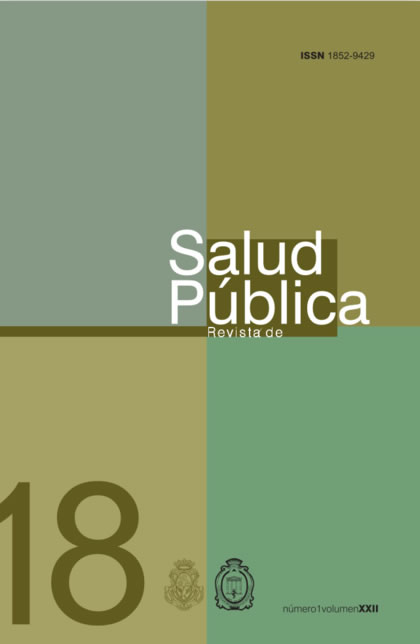PROFESSIONALS AND ANTINEOPLASTIC AGENT POLICES IN THE PUBLIC HEALTH SERVICE IN ROSARIO: QUALITATIVE STUDY
DOI:
https://doi.org/10.31052/1853.1180.v22.n1.17058Keywords:
health policies, drug, neoplastic agents, pharmaco-epidemiology.Abstract
Objective: To examine the antineoplastic agent polices in a Public Service of Oncology in Rosariofrom the professionals› perspective. Methods: Qualitative retrospective study using semistructured interviews to key informants from the Service. Period: January-June 2012. Axis: a) knowledge about oncology drug programs; b) regulatory framework; c) funding; d) oncology drug selection/ prescription/ administration tools; d) drug innovations and offlabel use; f) team-work; g) work setting. Results: Answers generally derived to the clinical area. They said they knew the National Cancer Program but was seen to be away from the everyday care practices. Regulations regarding performance within the service were more clearly observed. Jurisdiction problems were seen in the founding field. They referred to the International Guidelines of Clinical Practice, putting emphasis on the need to agree within the team. They cautiously observed the collecting agency. They said they received updated information about oncology drugs but hesitated when defining off- label. The work team was contextualized within the Municipal Public Heath Network. Conclusions: From the health professionals› perspective, the National Program was framed within a complexscenery with strengths and limitations. The qualitative approach shows aspects that may complement other studies.Downloads
References
Referencias Bibliográficas:
1. Instituto Nacional del Cáncer. Buenos As: Ministerio de Salud de la Nación. Análisis de la situación del cáncer en Argentina. [Disponible en: http://www.msal.gov.ar/inc/index.php/acerca-del-cancer/estadisticas]. [Último acceso: octubre 2015].
2. Organización Mundial de la Salud. Informe sobre la situación mundial de las enfermedades no transmisibles 2010. Resumen de Orientación. [Disponible en: http://www.who.int/nmh/publications/ncd_report_summary_es.pdf]. [Último acceso: noviembre 2015].
3. Maceira, D. Olaviaga, S. Mapa de actores del sector oncológico en la Argentina. Revista de Salud Pública.2011;1:17-28.
4. Ministerio de Salud. Legisalud Argentina. Ley 15766. [Disponible en: http://test.e-legis-ar.msal.gov.ar/leisref/public/showAct.php?id=19300]. [Último acceso: noviembre 2015].
5. Ministerio de Salud. Legisalud Argentina. Decreto 6180/1965. [Disponible en: http://test.e-legis-ar.msal.gov.ar/leisref/public/showAct.php?id=17900]. [Último acceso: noviembre 2015].
6. Secretaría de Estado de Salud Pública. Programa de Control de Cáncer. Resolución Secretarial Nº 2886/76. Argentina. 1976.
7. Taylor SJ, Bordan R. Introducción a los métodos cualitativos de investigación México: Editorial Paidos. 1996.
8. Municipalidad de Rosario. Descripción Centro de Especialidades Médicas Ambulatorias de Rosario “M. H. Zuasnábar” (CEMAR). [Disponible en: http://www.rosario.gov.ar/sitio/lugaresVisual/verLugar.do?id=1727]. [Último acceso: noviembre 2015].
9. Maceira D, Cejas C, Olaviaga S. Coordinación e integración: el desafío del sistema de salud argentino. Bs. As. Centro de Implementación de Políticas Públicas para la Equidad y el Crecimiento (CIPPEC). 2012.
10. Clinical Oncology Society of Australia. Guidelines for the Safe Prescribing, Dispensing and Administration of Cancer Chemotherapy. 2008. [Disponible en: https://www.cosa.org.au/media/1093/cosa_guidelines_safeprescribingchemo2008.pdf.]. [Último acceso: abril 2016].
11. Confalone Gregorián M. Uso de la evidencia científica para la toma de decisiones. Boletín INC Nº 15. Agosto 2014. [Disponible en: http://www.msal.gov.ar/inc/images/stories/downloads/comunicacion/boletines/boletin_n15_evaluacion-tecnologias-sanitarias.pdf]. [Último acceso: enero 2016].
12. Santa Cruz P. La industria farmacéutica y su influencia en la práctica clínica. Rev GPU. 2011;7;1:92-102.
13. Organización Panamerica de la Salud.OMS Argentina. Acreditan a la ANMAT como autoridad reguladora de medicamentos de referencia. [Disponible en: http://www.paho.org/arg/index.php?option=com_content&view=article&id=417:acreditan-anmat-autoridad-reguladora-medicamentos-referencia&Itemid=281]. [Último acceso: enero 2016].
14. Administración Nacional de Medicamentos, Alimentos y Tecnología Médica. ANMAT. Guía de Buenas Prácticas de Farmacovigilancia.2009. Ministerio de Salud. Argentina Circular 008/2009. (20/11/2009)
15. Real JP; Palchik V; Salamano M; Traverso ML; Palma S. Off label use of medicines in Argentina. Who wins and who loses? Pharmaceuticals Policy and Law. 2012;14:209-22.
16. Administración Nacional de Medicamentos, Alimentos y Tecnología Médica. ANMAT. Ministerio de Salud. Presidencia de la Nación. [Disponible en: http://www.anmat.gov.ar/comunicados/Indicaciones_de_medicamentos_fp.pdf]. [Último acceso: mayo 2016].
Downloads
Published
Issue
Section
License
Copyright (c) 2018 Escuela de Salud Pública y Ambiente. Facultad de Ciencias Médicas. Universidad Nacional de Córdoba

This work is licensed under a Creative Commons Attribution-NonCommercial 4.0 International License.
Authors who publish with this journal agree to the following terms:
- Authors retain copyright and grant the journal right of first publication with the work simultaneously licensed under a Creative Commons Attribution License which allows the work to be copied, distributed, exhibited and interpreted as long as it is not done for commercial purposes.
- Authors are able to enter into separate, additional contractual arrangements for the non-exclusive distribution of the journal's published version of the work (e.g., post it to an institutional repository or publish it in a book), with an acknowledgement of its initial publication in this journal.
- Authors are permitted and encouraged to post their work online (e.g., in institutional repositories or on their website) after the publication process. (See The Effect of Open Access). (See The Effect of Open Access).







